| Listing 1 - 8 of 8 |
Sort by
|
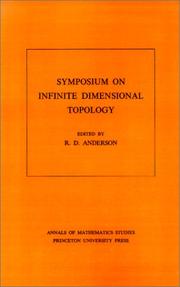
ISBN: 0691080879 1400881404 9780691080871 Year: 1972 Volume: 69 Publisher: Princeton (N.J.) : Princeton university press,
Abstract | Keywords | Export | Availability | Bookmark
 Loading...
Loading...Choose an application
- Reference Manager
- EndNote
- RefWorks (Direct export to RefWorks)
In essence the proceedings of the 1967 meeting in Baton Rouge, the volume offers significant papers in the topology of infinite dimensional linear spaces, fixed point theory in infinite dimensional spaces, infinite dimensional differential topology, and infinite dimensional pointset topology. Later results of the contributors underscore the basic soundness of this selection, which includes survey and expository papers, as well as reports of continuing research.
Topology --- Differential geometry. Global analysis --- Differential topology --- Functional analysis --- Congresses --- Analyse fonctionnnelle --- Geometry, Differential --- Anderson's theorem. --- Annihilator (ring theory). --- Automorphism. --- Baire measure. --- Banach algebra. --- Banach manifold. --- Banach space. --- Bounded operator. --- Cartesian product. --- Characterization (mathematics). --- Cohomology. --- Compact space. --- Complement (set theory). --- Complete metric space. --- Connected space. --- Continuous function. --- Convex set. --- Coset. --- Critical point (mathematics). --- Diagram (category theory). --- Differentiable manifold. --- Differential topology. --- Dimension (vector space). --- Dimension. --- Dimensional analysis. --- Dual space. --- Duality (mathematics). --- Endomorphism. --- Equivalence class. --- Euclidean space. --- Existential quantification. --- Explicit formulae (L-function). --- Exponential map (Riemannian geometry). --- Fixed-point theorem. --- Fréchet derivative. --- Fréchet space. --- Fuchsian group. --- Function space. --- Fundamental class. --- Haar measure. --- Hessian matrix. --- Hilbert space. --- Homeomorphism. --- Homology (mathematics). --- Homotopy group. --- Homotopy. --- Inclusion map. --- Infimum and supremum. --- Lebesgue space. --- Lefschetz fixed-point theorem. --- Limit point. --- Linear space (geometry). --- Locally convex topological vector space. --- Loop space. --- Mathematical optimization. --- Measure (mathematics). --- Metric space. --- Module (mathematics). --- Natural topology. --- Neighbourhood (mathematics). --- Normal space. --- Normed vector space. --- Open set. --- Ordinal number. --- Paracompact space. --- Partition of unity. --- Path space. --- Product topology. --- Quantifier (logic). --- Quotient space (linear algebra). --- Quotient space (topology). --- Radon measure. --- Reflexive space. --- Representation theorem. --- Riemannian manifold. --- Schauder fixed point theorem. --- Sign (mathematics). --- Simply connected space. --- Space form. --- Special case. --- Stiefel manifold. --- Strong operator topology. --- Subcategory. --- Submanifold. --- Subset. --- Tangent space. --- Teichmüller space. --- Theorem. --- Topological space. --- Topological vector space. --- Topology. --- Transfinite induction. --- Transfinite. --- Transversal (geometry). --- Transversality theorem. --- Tychonoff cube. --- Union (set theory). --- Unit sphere. --- Weak topology. --- Weakly compact. --- Differential topology - Congresses --- Functional analysis - Congresses --- Topology - Congresses --- Analyse fonctionnelle.
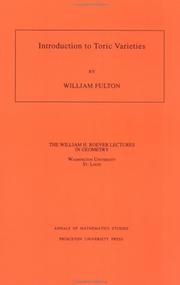
ISBN: 0691000492 0691033323 1400882524 Year: 1993 Publisher: Princeton, N.J. Princeton University Press
Abstract | Keywords | Export | Availability | Bookmark
 Loading...
Loading...Choose an application
- Reference Manager
- EndNote
- RefWorks (Direct export to RefWorks)
Toric varieties are algebraic varieties arising from elementary geometric and combinatorial objects such as convex polytopes in Euclidean space with vertices on lattice points. Since many algebraic geometry notions such as singularities, birational maps, cycles, homology, intersection theory, and Riemann-Roch translate into simple facts about polytopes, toric varieties provide a marvelous source of examples in algebraic geometry. In the other direction, general facts from algebraic geometry have implications for such polytopes, such as to the problem of the number of lattice points they contain. In spite of the fact that toric varieties are very special in the spectrum of all algebraic varieties, they provide a remarkably useful testing ground for general theories.The aim of this mini-course is to develop the foundations of the study of toric varieties, with examples, and describe some of these relations and applications. The text concludes with Stanley's theorem characterizing the numbers of simplicies in each dimension in a convex simplicial polytope. Although some general theorems are quoted without proof, the concrete interpretations via simplicial geometry should make the text accessible to beginners in algebraic geometry.
Algebraic geometry --- Differential geometry. Global analysis --- 512.7 --- Algebraic geometry. Commutative rings and algebras --- Toric varieties. --- 512.7 Algebraic geometry. Commutative rings and algebras --- Toric varieties --- Embeddings, Torus --- Torus embeddings --- Varieties, Toric --- Algebraic varieties --- Addition. --- Affine plane. --- Affine space. --- Affine variety. --- Alexander Grothendieck. --- Alexander duality. --- Algebraic curve. --- Algebraic group. --- Atiyah–Singer index theorem. --- Automorphism. --- Betti number. --- Big O notation. --- Characteristic class. --- Chern class. --- Chow group. --- Codimension. --- Cohomology. --- Combinatorics. --- Commutative property. --- Complete intersection. --- Convex polytope. --- Convex set. --- Coprime integers. --- Cotangent space. --- Dedekind sum. --- Dimension (vector space). --- Dimension. --- Direct proof. --- Discrete valuation ring. --- Discrete valuation. --- Disjoint union. --- Divisor (algebraic geometry). --- Divisor. --- Dual basis. --- Dual space. --- Equation. --- Equivalence class. --- Equivariant K-theory. --- Euler characteristic. --- Exact sequence. --- Explicit formula. --- Facet (geometry). --- Fundamental group. --- Graded ring. --- Grassmannian. --- H-vector. --- Hirzebruch surface. --- Hodge theory. --- Homogeneous coordinates. --- Homomorphism. --- Hypersurface. --- Intersection theory. --- Invertible matrix. --- Invertible sheaf. --- Isoperimetric inequality. --- Lattice (group). --- Leray spectral sequence. --- Limit point. --- Line bundle. --- Line segment. --- Linear subspace. --- Local ring. --- Mathematical induction. --- Mixed volume. --- Moduli space. --- Moment map. --- Monotonic function. --- Natural number. --- Newton polygon. --- Open set. --- Picard group. --- Pick's theorem. --- Polytope. --- Projective space. --- Quadric. --- Quotient space (topology). --- Regular sequence. --- Relative interior. --- Resolution of singularities. --- Restriction (mathematics). --- Resultant. --- Riemann–Roch theorem. --- Serre duality. --- Sign (mathematics). --- Simplex. --- Simplicial complex. --- Simultaneous equations. --- Spectral sequence. --- Subgroup. --- Subset. --- Summation. --- Surjective function. --- Tangent bundle. --- Theorem. --- Topology. --- Toric variety. --- Unit disk. --- Vector space. --- Weil conjecture. --- Zariski topology.
Book
ISBN: 0691079994 1400881986 9780691079998 Year: 1971 Volume: 38 Publisher: Princeton (N.J.): Princeton university press,
Abstract | Keywords | Export | Availability | Bookmark
 Loading...
Loading...Choose an application
- Reference Manager
- EndNote
- RefWorks (Direct export to RefWorks)
The description for this book, Linear Inequalities and Related Systems. (AM-38), Volume 38, will be forthcoming.
Operational research. Game theory --- Linear programming. --- Matrices. --- Game theory. --- Games, Theory of --- Theory of games --- Mathematical models --- Mathematics --- Algebra, Matrix --- Cracovians (Mathematics) --- Matrix algebra --- Matrixes (Algebra) --- Algebra, Abstract --- Algebra, Universal --- Production scheduling --- Programming (Mathematics) --- Banach space. --- Basic solution (linear programming). --- Big O notation. --- Bilinear form. --- Boundary (topology). --- Brouwer fixed-point theorem. --- Characterization (mathematics). --- Coefficient. --- Combination. --- Computation. --- Computational problem. --- Convex combination. --- Convex cone. --- Convex hull. --- Convex set. --- Corollary. --- Correlation and dependence. --- Cramer's rule. --- Cyclic permutation. --- Dedekind cut. --- Degeneracy (mathematics). --- Determinant. --- Diagram (category theory). --- Dilworth's theorem. --- Dimension (vector space). --- Directional derivative. --- Disjoint sets. --- Doubly stochastic matrix. --- Dual space. --- Duality (mathematics). --- Duality (optimization). --- Eigenvalues and eigenvectors. --- Elementary proof. --- Equation solving. --- Equation. --- Equivalence class. --- Euclidean space. --- Existence theorem. --- Existential quantification. --- Extreme point. --- Fixed-point theorem. --- Functional analysis. --- Fundamental theorem. --- General equilibrium theory. --- Hall's theorem. --- Hilbert space. --- Incidence matrix. --- Inequality (mathematics). --- Infimum and supremum. --- Invertible matrix. --- Kakutani fixed-point theorem. --- Lagrange multiplier. --- Linear equation. --- Linear inequality. --- Linear map. --- Linear space (geometry). --- Linear subspace. --- Loss function. --- Main diagonal. --- Mathematical induction. --- Mathematical optimization. --- Mathematical problem. --- Max-flow min-cut theorem. --- Maxima and minima. --- Maximal set. --- Maximum flow problem. --- Menger's theorem. --- Minor (linear algebra). --- Monotonic function. --- N-vector. --- Nonlinear programming. --- Nonnegative matrix. --- Parity (mathematics). --- Partially ordered set. --- Permutation matrix. --- Permutation. --- Polyhedron. --- Quantity. --- Representation theorem. --- Row and column vectors. --- Scientific notation. --- Sensitivity analysis. --- Set notation. --- Sign (mathematics). --- Simplex algorithm. --- Simultaneous equations. --- Solution set. --- Special case. --- Subset. --- Summation. --- System of linear equations. --- Theorem. --- Transpose. --- Unit sphere. --- Unit vector. --- Upper and lower bounds. --- Variable (mathematics). --- Vector space. --- Von Neumann's theorem.
Book
ISBN: 0691145423 0691145415 9780691145419 9780691145426 1282645064 9786612645068 1400835402 9781400835409 9781282645066 Year: 2010 Publisher: Princeton : Princeton University Press,
Abstract | Keywords | Export | Availability | Bookmark
 Loading...
Loading...Choose an application
- Reference Manager
- EndNote
- RefWorks (Direct export to RefWorks)
Ramsey theory is a fast-growing area of combinatorics with deep connections to other fields of mathematics such as topological dynamics, ergodic theory, mathematical logic, and algebra. The area of Ramsey theory dealing with Ramsey-type phenomena in higher dimensions is particularly useful. Introduction to Ramsey Spaces presents in a systematic way a method for building higher-dimensional Ramsey spaces from basic one-dimensional principles. It is the first book-length treatment of this area of Ramsey theory, and emphasizes applications for related and surrounding fields of mathematics, such as set theory, combinatorics, real and functional analysis, and topology. In order to facilitate accessibility, the book gives the method in its axiomatic form with examples that cover many important parts of Ramsey theory both finite and infinite. An exciting new direction for combinatorics, this book will interest graduate students and researchers working in mathematical subdisciplines requiring the mastery and practice of high-dimensional Ramsey theory.
Algebraic spaces. --- Ramsey theory. --- Ramsey theory --- Algebraic spaces --- Mathematics --- Algebra --- Physical Sciences & Mathematics --- Spaces, Algebraic --- Geometry, Algebraic --- Combinatorial analysis --- Graph theory --- Analytic set. --- Axiom of choice. --- Baire category theorem. --- Baire space. --- Banach space. --- Bijection. --- Binary relation. --- Boolean prime ideal theorem. --- Borel equivalence relation. --- Borel measure. --- Borel set. --- C0. --- Cantor cube. --- Cantor set. --- Cantor space. --- Cardinality. --- Characteristic function (probability theory). --- Characterization (mathematics). --- Combinatorics. --- Compact space. --- Compactification (mathematics). --- Complete metric space. --- Completely metrizable space. --- Constructible universe. --- Continuous function (set theory). --- Continuous function. --- Corollary. --- Countable set. --- Counterexample. --- Decision problem. --- Dense set. --- Diagonalization. --- Dimension (vector space). --- Dimension. --- Discrete space. --- Disjoint sets. --- Dual space. --- Embedding. --- Equation. --- Equivalence relation. --- Existential quantification. --- Family of sets. --- Forcing (mathematics). --- Forcing (recursion theory). --- Gap theorem. --- Geometry. --- Ideal (ring theory). --- Infinite product. --- Lebesgue measure. --- Limit point. --- Lipschitz continuity. --- Mathematical induction. --- Mathematical problem. --- Mathematics. --- Metric space. --- Metrization theorem. --- Monotonic function. --- Natural number. --- Natural topology. --- Neighbourhood (mathematics). --- Null set. --- Open set. --- Order type. --- Partial function. --- Partially ordered set. --- Peano axioms. --- Point at infinity. --- Pointwise. --- Polish space. --- Probability measure. --- Product measure. --- Product topology. --- Property of Baire. --- Ramsey's theorem. --- Right inverse. --- Scalar multiplication. --- Schauder basis. --- Semigroup. --- Sequence. --- Sequential space. --- Set (mathematics). --- Set theory. --- Sperner family. --- Subsequence. --- Subset. --- Subspace topology. --- Support function. --- Symmetric difference. --- Theorem. --- Topological dynamics. --- Topological group. --- Topological space. --- Topology. --- Tree (data structure). --- Unit interval. --- Unit sphere. --- Variable (mathematics). --- Well-order. --- Zorn's lemma.
Book
ISBN: 0691080747 1322884773 0691621411 0691648077 1400868572 9780691080741 Year: 1970 Publisher: Princeton: Princeton university press,
Abstract | Keywords | Export | Availability | Bookmark
 Loading...
Loading...Choose an application
- Reference Manager
- EndNote
- RefWorks (Direct export to RefWorks)
Encompassing both introductory and more advanced research material, these notes deal with the author's contributions to stochastic processes and focus on Brownian motion processes and its derivative white noise.Originally published in 1970.The Princeton Legacy Library uses the latest print-on-demand technology to again make available previously out-of-print books from the distinguished backlist of Princeton University Press. These editions preserve the original texts of these important books while presenting them in durable paperback and hardcover editions. The goal of the Princeton Legacy Library is to vastly increase access to the rich scholarly heritage found in the thousands of books published by Princeton University Press since its founding in 1905.
Stationary processes --- Stationary processes. --- Stochastic processes --- 519.216 --- 519.216 Stochastic processes in general. Prediction theory. Stopping times. Martingales --- Stochastic processes in general. Prediction theory. Stopping times. Martingales --- Bochner integral. --- Bochner's theorem. --- Bounded operator. --- Bounded variation. --- Brownian motion. --- Characteristic exponent. --- Characteristic function (probability theory). --- Complexification. --- Compound Poisson process. --- Computation. --- Conditional expectation. --- Continuous function (set theory). --- Continuous function. --- Continuous linear operator. --- Convergence of random variables. --- Coset. --- Covariance function. --- Cyclic subspace. --- Cylinder set. --- Degrees of freedom (statistics). --- Derivative. --- Differential equation. --- Dimension (vector space). --- Dirac delta function. --- Discrete spectrum. --- Distribution function. --- Dual space. --- Eigenfunction. --- Equation. --- Existential quantification. --- Exponential distribution. --- Exponential function. --- Finite difference. --- Fourier series. --- Fourier transform. --- Function (mathematics). --- Function space. --- Gaussian measure. --- Gaussian process. --- Harmonic analysis. --- Hermite polynomials. --- Hilbert space. --- Homeomorphism. --- Independence (probability theory). --- Independent and identically distributed random variables. --- Indicator function. --- Infinitesimal generator (stochastic processes). --- Integral equation. --- Isometry. --- Joint probability distribution. --- Langevin equation. --- Lebesgue measure. --- Lie algebra. --- Limit superior and limit inferior. --- Linear combination. --- Linear function. --- Linear interpolation. --- Linear subspace. --- Mean squared error. --- Measure (mathematics). --- Monotonic function. --- Normal distribution. --- Normal subgroup. --- Nuclear space. --- One-parameter group. --- Orthogonality. --- Orthogonalization. --- Parameter. --- Poisson point process. --- Polynomial. --- Probability distribution. --- Probability measure. --- Probability space. --- Probability. --- Projective linear group. --- Radon–Nikodym theorem. --- Random function. --- Random variable. --- Reproducing kernel Hilbert space. --- Self-adjoint operator. --- Self-adjoint. --- Semigroup. --- Shift operator. --- Special case. --- Stable process. --- Stationary process. --- Stochastic differential equation. --- Stochastic process. --- Stochastic. --- Subgroup. --- Summation. --- Symmetrization. --- Theorem. --- Transformation semigroup. --- Unitary operator. --- Unitary representation. --- Unitary transformation. --- Variance. --- White noise. --- Zero element.
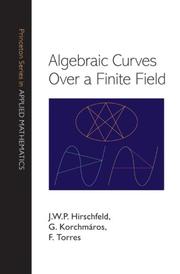
ISBN: 1400847419 9781400847419 1306988608 9781306988605 9781400847426 1400847427 0691096791 9780691096797 9780691096797 Year: 2008 Publisher: Princeton, New Jersey : Princeton University Press,
Abstract | Keywords | Export | Availability | Bookmark
 Loading...
Loading...Choose an application
- Reference Manager
- EndNote
- RefWorks (Direct export to RefWorks)
This book provides an accessible and self-contained introduction to the theory of algebraic curves over a finite field, a subject that has been of fundamental importance to mathematics for many years and that has essential applications in areas such as finite geometry, number theory, error-correcting codes, and cryptology. Unlike other books, this one emphasizes the algebraic geometry rather than the function field approach to algebraic curves. The authors begin by developing the general theory of curves over any field, highlighting peculiarities occurring for positive characteristic and requiring of the reader only basic knowledge of algebra and geometry. The special properties that a curve over a finite field can have are then discussed. The geometrical theory of linear series is used to find estimates for the number of rational points on a curve, following the theory of Stöhr and Voloch. The approach of Hasse and Weil via zeta functions is explained, and then attention turns to more advanced results: a state-of-the-art introduction to maximal curves over finite fields is provided; a comprehensive account is given of the automorphism group of a curve; and some applications to coding theory and finite geometry are described. The book includes many examples and exercises. It is an indispensable resource for researchers and the ideal textbook for graduate students.
Curves, Algebraic. --- Finite fields (Algebra) --- Modular fields (Algebra) --- Algebra, Abstract --- Algebraic fields --- Galois theory --- Modules (Algebra) --- Algebraic curves --- Algebraic varieties --- Abelian group. --- Abelian variety. --- Affine plane. --- Affine space. --- Affine variety. --- Algebraic closure. --- Algebraic curve. --- Algebraic equation. --- Algebraic extension. --- Algebraic function. --- Algebraic geometry. --- Algebraic integer. --- Algebraic number field. --- Algebraic number theory. --- Algebraic number. --- Algebraic variety. --- Algebraically closed field. --- Applied mathematics. --- Automorphism. --- Birational invariant. --- Characteristic exponent. --- Classification theorem. --- Clifford's theorem. --- Combinatorics. --- Complex number. --- Computation. --- Cyclic group. --- Cyclotomic polynomial. --- Degeneracy (mathematics). --- Degenerate conic. --- Divisor (algebraic geometry). --- Divisor. --- Dual curve. --- Dual space. --- Elliptic curve. --- Equation. --- Fermat curve. --- Finite field. --- Finite geometry. --- Finite group. --- Formal power series. --- Function (mathematics). --- Function field. --- Fundamental theorem. --- Galois extension. --- Galois theory. --- Gauss map. --- General position. --- Generic point. --- Geometry. --- Homogeneous polynomial. --- Hurwitz's theorem. --- Hyperelliptic curve. --- Hyperplane. --- Identity matrix. --- Inequality (mathematics). --- Intersection number (graph theory). --- Intersection number. --- J-invariant. --- Line at infinity. --- Linear algebra. --- Linear map. --- Mathematical induction. --- Mathematics. --- Menelaus' theorem. --- Modular curve. --- Natural number. --- Number theory. --- Parity (mathematics). --- Permutation group. --- Plane curve. --- Point at infinity. --- Polar curve. --- Polygon. --- Polynomial. --- Power series. --- Prime number. --- Projective plane. --- Projective space. --- Quadratic transformation. --- Quadric. --- Resolution of singularities. --- Riemann hypothesis. --- Scalar multiplication. --- Scientific notation. --- Separable extension. --- Separable polynomial. --- Sign (mathematics). --- Singular point of a curve. --- Special case. --- Subgroup. --- Sylow theorems. --- System of linear equations. --- Tangent. --- Theorem. --- Transcendence degree. --- Upper and lower bounds. --- Valuation ring. --- Variable (mathematics). --- Vector space.
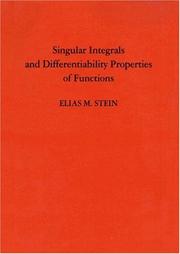
ISBN: 0691080798 1400883881 9780691080796 Year: 1986 Volume: 30 Publisher: Princeton (N.J.): Princeton university press,
Abstract | Keywords | Export | Availability | Bookmark
 Loading...
Loading...Choose an application
- Reference Manager
- EndNote
- RefWorks (Direct export to RefWorks)
Singular integrals are among the most interesting and important objects of study in analysis, one of the three main branches of mathematics. They deal with real and complex numbers and their functions. In this book, Princeton professor Elias Stein, a leading mathematical innovator as well as a gifted expositor, produced what has been called the most influential mathematics text in the last thirty-five years. One reason for its success as a text is its almost legendary presentation: Stein takes arcane material, previously understood only by specialists, and makes it accessible even to beginning graduate students. Readers have reflected that when you read this book, not only do you see that the greats of the past have done exciting work, but you also feel inspired that you can master the subject and contribute to it yourself. Singular integrals were known to only a few specialists when Stein's book was first published. Over time, however, the book has inspired a whole generation of researchers to apply its methods to a broad range of problems in many disciplines, including engineering, biology, and finance. Stein has received numerous awards for his research, including the Wolf Prize of Israel, the Steele Prize, and the National Medal of Science. He has published eight books with Princeton, including Real Analysis in 2005.
Functions of real variables. --- Harmonic analysis. --- Singular integrals. --- Multiplicateurs (analyse mathématique) --- Multipliers (Mathematical analysis) --- Functional analysis --- Harmonic analysis. Fourier analysis --- Functions of real variables --- Harmonic analysis --- Singular integrals --- Fonctions de variables réelles --- Analyse harmonique --- Intégrales singulières --- Fonctions de plusieurs variables réelles --- Calcul différentiel --- Functions of several real variables --- Differential calculus --- 517.518.5 --- Integrals, Singular --- Integral operators --- Integral transforms --- Analysis (Mathematics) --- Functions, Potential --- Potential functions --- Banach algebras --- Calculus --- Mathematical analysis --- Mathematics --- Bessel functions --- Fourier series --- Harmonic functions --- Time-series analysis --- Real variables --- Functions of complex variables --- 517.518.5 Theory of the Fourier integral --- Theory of the Fourier integral --- A priori estimate. --- Analytic function. --- Banach algebra. --- Banach space. --- Basis (linear algebra). --- Bessel function. --- Bessel potential. --- Big O notation. --- Borel measure. --- Boundary value problem. --- Bounded function. --- Bounded operator. --- Bounded set (topological vector space). --- Bounded variation. --- Boundedness. --- Cartesian product. --- Change of variables. --- Characteristic function (probability theory). --- Characterization (mathematics). --- Commutative property. --- Complex analysis. --- Complex number. --- Continuous function (set theory). --- Continuous function. --- Convolution. --- Derivative. --- Difference "ient. --- Difference set. --- Differentiable function. --- Dimension (vector space). --- Dimensional analysis. --- Dirac measure. --- Dirichlet problem. --- Distribution function. --- Division by zero. --- Dot product. --- Dual space. --- Equation. --- Existential quantification. --- Family of sets. --- Fatou's theorem. --- Finite difference. --- Fourier analysis. --- Fourier series. --- Fourier transform. --- Function space. --- Green's theorem. --- Harmonic function. --- Hilbert space. --- Hilbert transform. --- Homogeneous function. --- Infimum and supremum. --- Integral transform. --- Interpolation theorem. --- Interval (mathematics). --- Linear map. --- Lipschitz continuity. --- Lipschitz domain. --- Locally integrable function. --- Marcinkiewicz interpolation theorem. --- Mathematical induction. --- Maximal function. --- Maximum principle. --- Mean value theorem. --- Measure (mathematics). --- Modulus of continuity. --- Multiple integral. --- Open set. --- Order of integration. --- Orthogonality. --- Orthonormal basis. --- Partial derivative. --- Partial differential equation. --- Partition of unity. --- Periodic function. --- Plancherel theorem. --- Pointwise. --- Poisson kernel. --- Polynomial. --- Real variable. --- Rectangle. --- Riesz potential. --- Riesz transform. --- Scientific notation. --- Sign (mathematics). --- Singular integral. --- Sobolev space. --- Special case. --- Splitting lemma. --- Subsequence. --- Subset. --- Summation. --- Support (mathematics). --- Theorem. --- Theory. --- Total order. --- Unit vector. --- Variable (mathematics). --- Zero of a function. --- Fonctions de plusieurs variables réelles --- Calcul différentiel --- Multiplicateurs (analyse mathématique)
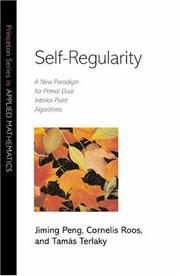
ISBN: 1282087606 9786612087608 140082513X 9781400825134 1400814529 9781400814527 9780691091938 0691091935 9780691091921 0691091927 0691091927 9781282087606 Year: 2002 Publisher: Princeton, N.J. ; Oxford : Princeton University Press,
Abstract | Keywords | Export | Availability | Bookmark
 Loading...
Loading...Choose an application
- Reference Manager
- EndNote
- RefWorks (Direct export to RefWorks)
Research on interior-point methods (IPMs) has dominated the field of mathematical programming for the last two decades. Two contrasting approaches in the analysis and implementation of IPMs are the so-called small-update and large-update methods, although, until now, there has been a notorious gap between the theory and practical performance of these two strategies. This book comes close to bridging that gap, presenting a new framework for the theory of primal-dual IPMs based on the notion of the self-regularity of a function. The authors deal with linear optimization, nonlinear complementarity problems, semidefinite optimization, and second-order conic optimization problems. The framework also covers large classes of linear complementarity problems and convex optimization. The algorithm considered can be interpreted as a path-following method or a potential reduction method. Starting from a primal-dual strictly feasible point, the algorithm chooses a search direction defined by some Newton-type system derived from the self-regular proximity. The iterate is then updated, with the iterates staying in a certain neighborhood of the central path until an approximate solution to the problem is found. By extensively exploring some intriguing properties of self-regular functions, the authors establish that the complexity of large-update IPMs can come arbitrarily close to the best known iteration bounds of IPMs. Researchers and postgraduate students in all areas of linear and nonlinear optimization will find this book an important and invaluable aid to their work.
Interior-point methods. --- Mathematical optimization. --- Programming (Mathematics). --- Mathematical optimization --- Interior-point methods --- Programming (Mathematics) --- Civil & Environmental Engineering --- Engineering & Applied Sciences --- Operations Research --- Mathematical programming --- Goal programming --- Algorithms --- Functional equations --- Operations research --- Optimization (Mathematics) --- Optimization techniques --- Optimization theory --- Systems optimization --- Mathematical analysis --- Maxima and minima --- Simulation methods --- System analysis --- 519.85 --- 681.3*G16 --- 681.3*G16 Optimization: constrained optimization; gradient methods; integer programming; least squares methods; linear programming; nonlinear programming (Numericalanalysis) --- Optimization: constrained optimization; gradient methods; integer programming; least squares methods; linear programming; nonlinear programming (Numericalanalysis) --- 519.85 Mathematical programming --- Accuracy and precision. --- Algorithm. --- Analysis of algorithms. --- Analytic function. --- Associative property. --- Barrier function. --- Binary number. --- Block matrix. --- Combination. --- Combinatorial optimization. --- Combinatorics. --- Complexity. --- Conic optimization. --- Continuous optimization. --- Control theory. --- Convex optimization. --- Delft University of Technology. --- Derivative. --- Differentiable function. --- Directional derivative. --- Division by zero. --- Dual space. --- Duality (mathematics). --- Duality gap. --- Eigenvalues and eigenvectors. --- Embedding. --- Equation. --- Estimation. --- Existential quantification. --- Explanation. --- Feasible region. --- Filter design. --- Function (mathematics). --- Implementation. --- Instance (computer science). --- Invertible matrix. --- Iteration. --- Jacobian matrix and determinant. --- Jordan algebra. --- Karmarkar's algorithm. --- Karush–Kuhn–Tucker conditions. --- Line search. --- Linear complementarity problem. --- Linear function. --- Linear programming. --- Lipschitz continuity. --- Local convergence. --- Loss function. --- Mathematician. --- Mathematics. --- Matrix function. --- McMaster University. --- Monograph. --- Multiplication operator. --- Newton's method. --- Nonlinear programming. --- Nonlinear system. --- Notation. --- Operations research. --- Optimal control. --- Optimization problem. --- Parameter (computer programming). --- Parameter. --- Pattern recognition. --- Polyhedron. --- Polynomial. --- Positive semidefinite. --- Positive-definite matrix. --- Quadratic function. --- Requirement. --- Result. --- Scientific notation. --- Second derivative. --- Self-concordant function. --- Sensitivity analysis. --- Sign (mathematics). --- Signal processing. --- Simplex algorithm. --- Simultaneous equations. --- Singular value. --- Smoothness. --- Solution set. --- Solver. --- Special case. --- Subset. --- Suggestion. --- Technical report. --- Theorem. --- Theory. --- Time complexity. --- Two-dimensional space. --- Upper and lower bounds. --- Variable (computer science). --- Variable (mathematics). --- Variational inequality. --- Variational principle. --- Without loss of generality. --- Worst-case complexity. --- Yurii Nesterov. --- Mathematical Optimization --- Mathematics --- Programming (mathematics)
| Listing 1 - 8 of 8 |
Sort by
|

 Search
Search Feedback
Feedback About UniCat
About UniCat  Help
Help News
News